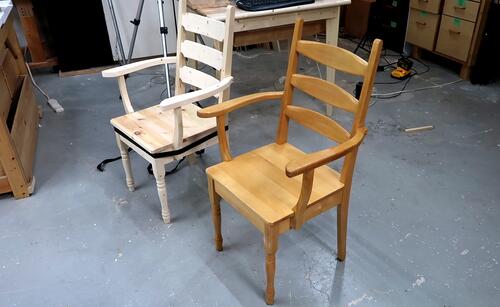 I wanted to make some chairs like the ones my dad used to make.
I wanted to make some chairs like the ones my dad used to make.
 I wanted to make some chairs like the ones my dad used to make.
I wanted to make some chairs like the ones my dad used to make.
My dad made a lot of dining tables for customers and often they wanted some chairs to go with it. My dad didn't like making chairs much, until he came up with this design some time around 1985. From then on, all his chairs followed this basic design. These chairs are simple and solid, and I don't know of any of these chairs to have failed from use, though one did fail from being kept in a wet basement, and the seat expanded too much and pushed the joints apart.
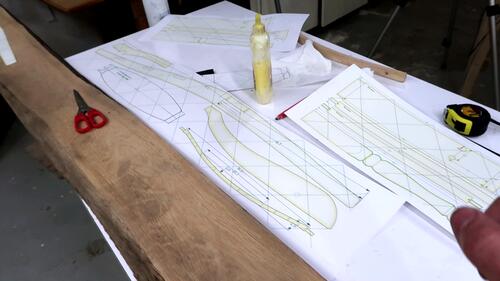 I made a detailed CAD model of the chairs, then printed out 1:1 templates using
my BigPrint program. I printed them
on individual 8x5x11" (approximately A4 sized) sheets of card stock,
then joined them into a bigger sheet with glue stick.
I made a detailed CAD model of the chairs, then printed out 1:1 templates using
my BigPrint program. I printed them
on individual 8x5x11" (approximately A4 sized) sheets of card stock,
then joined them into a bigger sheet with glue stick.
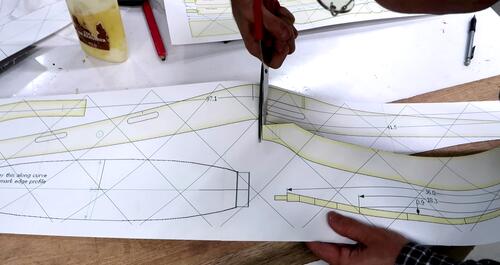 The card stock loads into a regular ink jet printer, so long as the printer
has a relatively straight-through paper path it works. Double sided printing
probably wouldn't work.
The card stock loads into a regular ink jet printer, so long as the printer
has a relatively straight-through paper path it works. Double sided printing
probably wouldn't work.
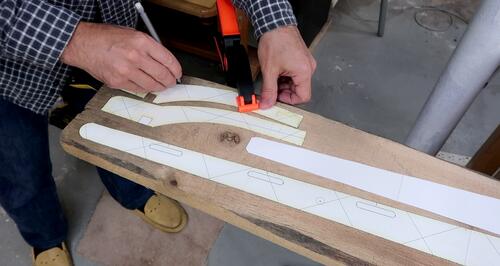 I printed each part twice so I could lay out how to cut up the wood. This board
has a knot on the end and a crack, so I'm working out how to
make good use of it and avoid the defects. I also want to have good
grain orientation for the parts.
I printed each part twice so I could lay out how to cut up the wood. This board
has a knot on the end and a crack, so I'm working out how to
make good use of it and avoid the defects. I also want to have good
grain orientation for the parts.
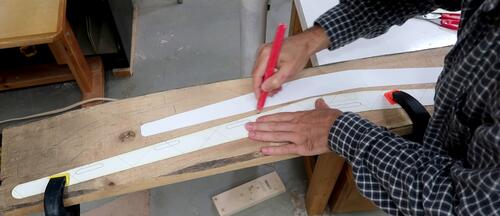 The card stock templates are stiff enough that I can trace around them with
a pencil without distorting them, even for the long and skinny chair back
parts, though I clamped those down in three places to keep them from
moving around.
The card stock templates are stiff enough that I can trace around them with
a pencil without distorting them, even for the long and skinny chair back
parts, though I clamped those down in three places to keep them from
moving around.
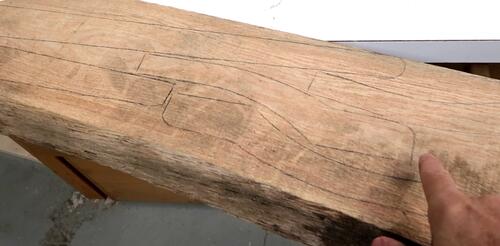 Nested chair parts laid out on the board.
Nested chair parts laid out on the board.
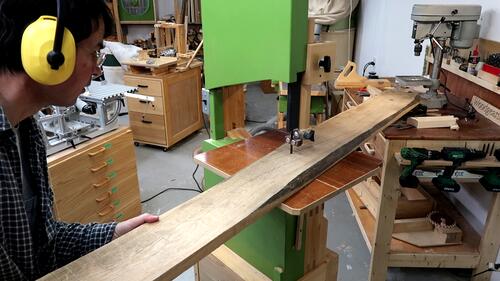 Cutting them out, just cutting the big board in half between
the laid out parts was tricky.
Cutting them out, just cutting the big board in half between
the laid out parts was tricky.
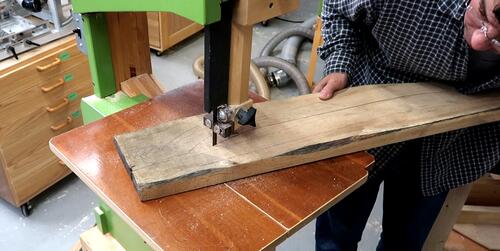 I gave no consideration to how to bandsaw these out when I laid them out,
so cutting them out was a challenge.
I gave no consideration to how to bandsaw these out when I laid them out,
so cutting them out was a challenge.
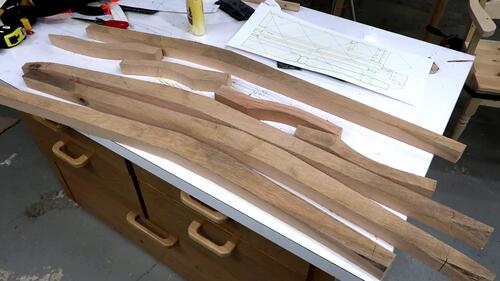 Chair back uprights and armrest supports cut out. This board is thicker
than the other boards, so I cut the parts that need to be the thickest out
of this board.
Chair back uprights and armrest supports cut out. This board is thicker
than the other boards, so I cut the parts that need to be the thickest out
of this board.
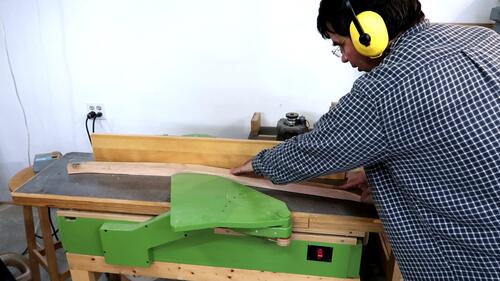 Then flattening the pieces on the jointer.
I cut them out before flattening
so didn't lose as much thickness from flattening the cupped board.
Then flattening the pieces on the jointer.
I cut them out before flattening
so didn't lose as much thickness from flattening the cupped board.
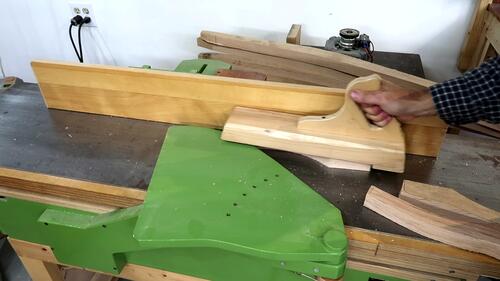 The armrest supports were a bit easier.
The armrest supports were a bit easier.
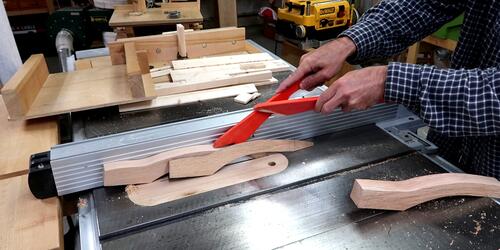 Cutting the armrests down to thickness. I did these on the table saw.
Cutting the armrests down to thickness. I did these on the table saw.
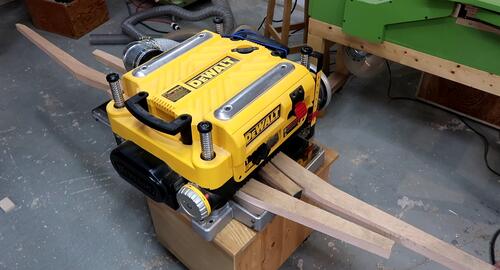 I could have done the chair backs to thickness on the table saw as well, but
it was less work to just run them through the thickness planer
a few times.
I could have done the chair backs to thickness on the table saw as well, but
it was less work to just run them through the thickness planer
a few times.
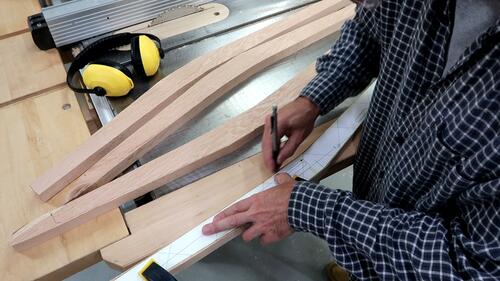 After flattening the pieces, I traced them again more precisely.
After flattening the pieces, I traced them again more precisely.
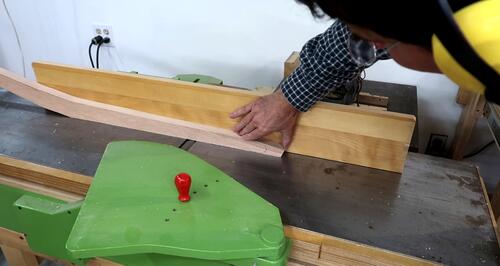 I used the jointer to get the front of the chair backs smooth and straight.
I used the jointer to get the front of the chair backs smooth and straight.
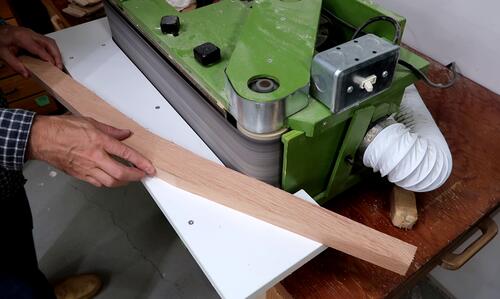 But I had to use my belt sander
to smooth the inside curves of the back.
But I had to use my belt sander
to smooth the inside curves of the back.
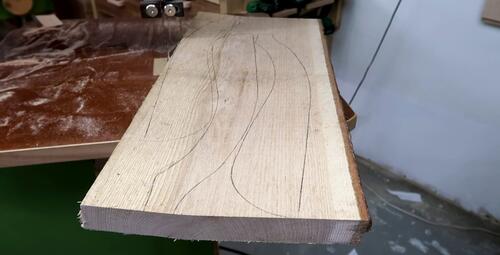 Three armrests out of another cupped piece of board.
Three armrests out of another cupped piece of board.
Getting the boards flat and smooth before cutting the parts out would be less work, but I would have lost too much thickness from flattening the pieces if I went that route.
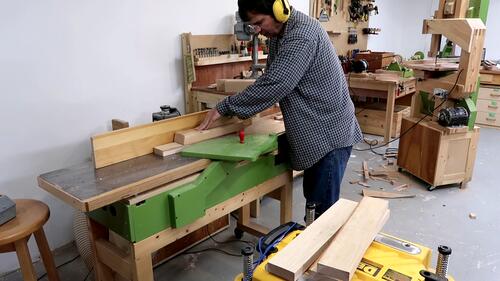 After that, I milled the rectangular pieces for the apron rails (the part
that joints the legs together under the seats)
After that, I milled the rectangular pieces for the apron rails (the part
that joints the legs together under the seats)
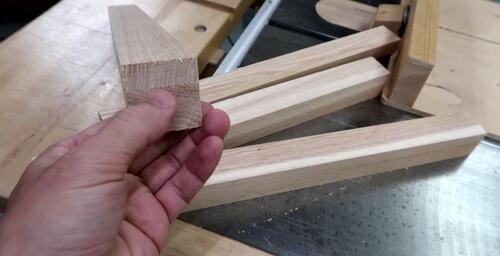 The front legs are turned and I had to glue two pieces together to get
enough thickness.
The front legs are turned and I had to glue two pieces together to get
enough thickness.
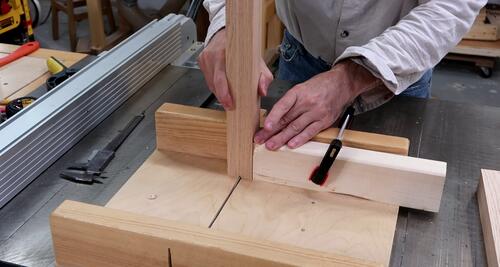 I used a table saw sled to make a shallow cut in the middle on both ends,
butting from all sides to ensure that I cut in the middle.
I used a table saw sled to make a shallow cut in the middle on both ends,
butting from all sides to ensure that I cut in the middle.
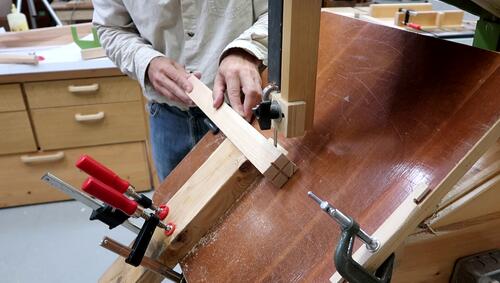 I cut the corners off on the bandsaw to speed up turning the legs round.
I cut the corners off on the bandsaw to speed up turning the legs round.
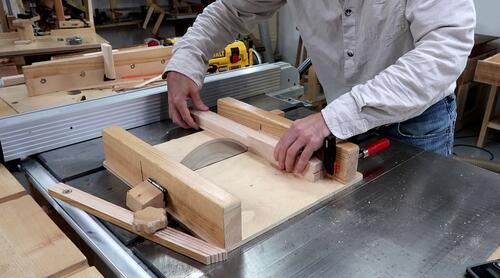 I used my table saw sled with the blade raised high, and my feather board
clamped to the saw table behind the sled to limit how far the sled would
go. That way the front edge of the blade made 45° cut to cut
the ends of the corner pieces I cut on the bandsaw.
I used my table saw sled with the blade raised high, and my feather board
clamped to the saw table behind the sled to limit how far the sled would
go. That way the front edge of the blade made 45° cut to cut
the ends of the corner pieces I cut on the bandsaw.
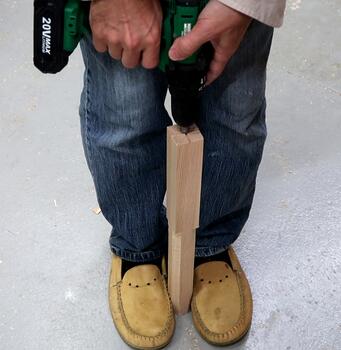
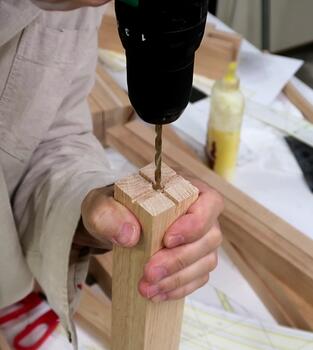 I used a countersink bit to cut a cone in the end and drilled
a small hole in the center of the cone to prpare the ends
for the lathe.
I used a countersink bit to cut a cone in the end and drilled
a small hole in the center of the cone to prpare the ends
for the lathe.
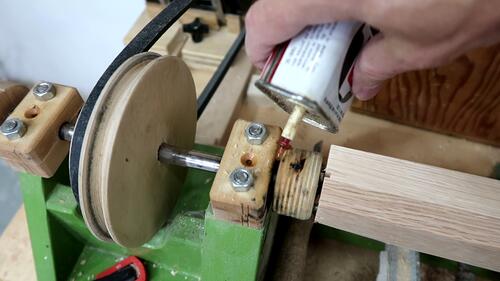 I'm using my homemade wooden lathe
to turn the spindles. It's not as good as lathes made of cast iron,
but it does the job, and it's light enough that its easy to lift on top of
a cabinet when I'm not using it.
I haven't done any turning since 2016 when I made
this wooden ball bearing, so it's the
right kind of lathe for me.
I'm using my homemade wooden lathe
to turn the spindles. It's not as good as lathes made of cast iron,
but it does the job, and it's light enough that its easy to lift on top of
a cabinet when I'm not using it.
I haven't done any turning since 2016 when I made
this wooden ball bearing, so it's the
right kind of lathe for me.
The lathe has wooden bearings and these need to be oiled every time the lathe is used. But when I turned the first spindle, I forgot to oil the washers that form the thrust bearing. They got hot enough that they started to smoke!
The lathe also doesn't have a live center on the tail stock, so the wood just spins against a fixed cone on the lathe. The tail stock end of the workpiece also needs to be oiled.
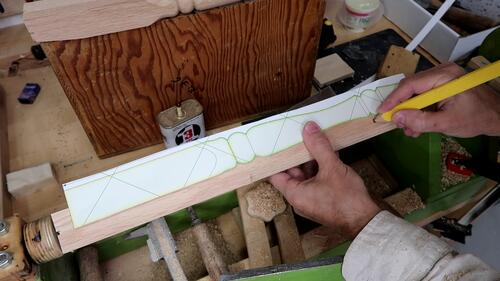 Marking key points of the spindle design on the leg.
Marking key points of the spindle design on the leg.
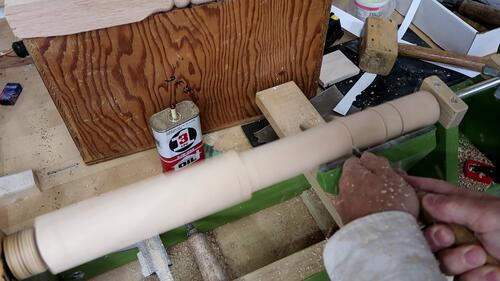 Then using a parting tool to mark these spots.
Then using a parting tool to mark these spots.
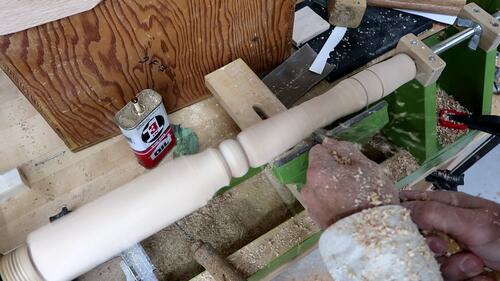 After that, turning it down and adding some detail.
After that, turning it down and adding some detail.
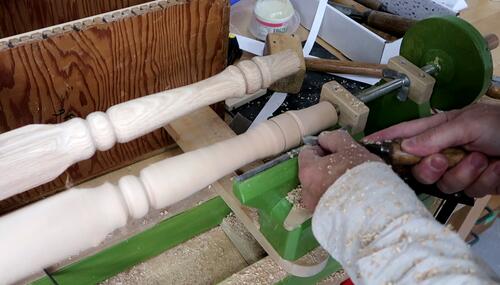 I turned the first spindle strictly from my drawing to make sure the drawing
is good, but then mounted the first spindle behind the lathe as a visual
reference. Just eyeballing against a reference cuts down on checking
and measuring a lot.
I turned the first spindle strictly from my drawing to make sure the drawing
is good, but then mounted the first spindle behind the lathe as a visual
reference. Just eyeballing against a reference cuts down on checking
and measuring a lot.
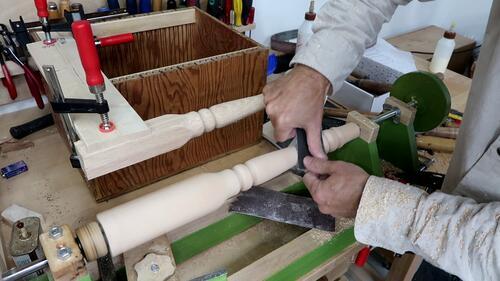 Then sanding. It's useful to reverse the direction of a lathe between
switching to finer grits, but the motor I have on this lathe isn't reversible.
So I just took the spindle out and flipped it end to end to reverse
the spindle instead of the rotation.
Then sanding. It's useful to reverse the direction of a lathe between
switching to finer grits, but the motor I have on this lathe isn't reversible.
So I just took the spindle out and flipped it end to end to reverse
the spindle instead of the rotation.
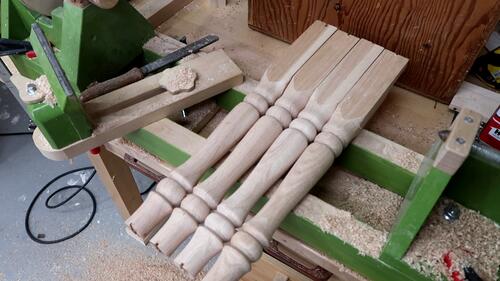 Four similar spindles. Not identical, but close enough that the differences
is hard to notice on a chair.
Four similar spindles. Not identical, but close enough that the differences
is hard to notice on a chair.
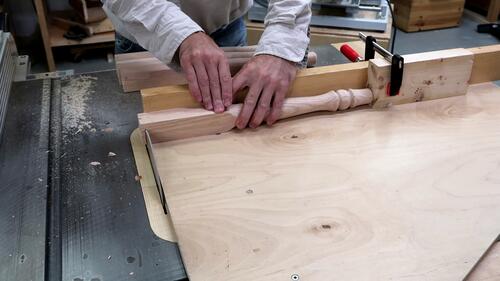 Then cutting the waste off the ends. This eliminates the bits with divots
and oil on them.
Then cutting the waste off the ends. This eliminates the bits with divots
and oil on them.
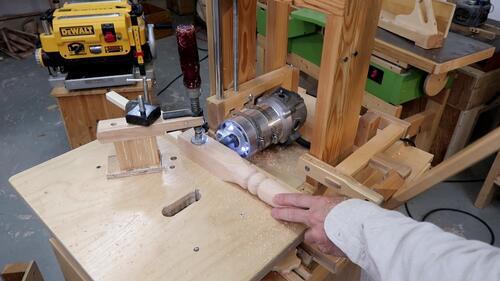
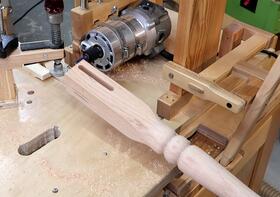 And cutting the mortises into the top on my
slot mortiser.
And cutting the mortises into the top on my
slot mortiser.
It's best to cut these after turning because they would have added to imbalance of the workpiece.
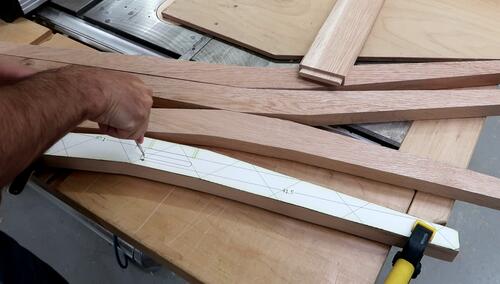 I marked the mortise location for the back legs of the chairs by laying
my template on top of it and punching through it with an awl.
I marked the mortise location for the back legs of the chairs by laying
my template on top of it and punching through it with an awl.
The other leg is a mirror image of this, so I put the template on it upside-down. I could see where I punched through the template previously, so I just punched through these hole again from the other side.
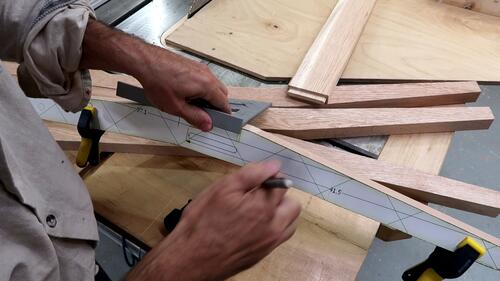 Also transferring the mortise on the front of the back leg to the edge with
a square.
Also transferring the mortise on the front of the back leg to the edge with
a square.
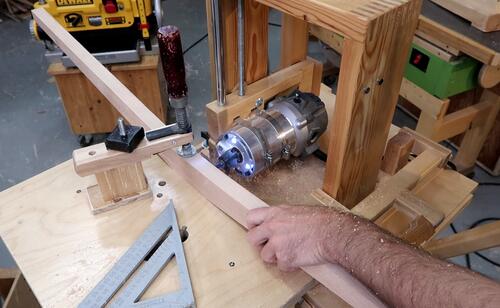 Then mortising the legs, first on the flat part...
Then mortising the legs, first on the flat part...